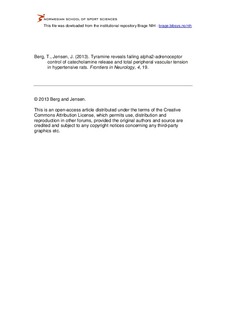| dc.contributor.author | Berg, Torill | |
| dc.contributor.author | Jensen, Jørgen | |
| dc.date.accessioned | 2013-04-11T06:58:40Z | |
| dc.date.available | 2013-04-11T06:58:40Z | |
| dc.date.issued | 2013-02-28 | |
| dc.identifier | Seksjon for fysisk prestasjonsevne / Department of Physical Performance | |
| dc.identifier.citation | Frontiers i Neuroscience. 2013, 4, 19 | no_NO |
| dc.identifier.issn | 1662-453X | |
| dc.identifier.issn | 1662-453X | |
| dc.identifier.uri | http://hdl.handle.net/11250/170984 | |
| dc.description | © 2013 Berg and Jensen. This is an open-access article distributed under the terms of the Creative Commons Attribution License, which permits use, distribution and reproduction in other forums, provided the original authors and source are credited and subject to any copyright notices concerning any third-party graphics etc. | no_NO |
| dc.description.abstract | α2-Adrenoceptor-activation lowers central sympathetic output, peripheral, vesicular norepinephrine release, epinephrine secretion, and modulates vascular tension. We previously demonstrated that α2-adrenoceptor-mediated inhibition of basal norepinephrine release was not reflected in plasma unless re-uptake through the norepinephrine transporter (NET) was blocked. Tyramine activates reverse norepinephrine transport through NET. Here we tested the hypothesis that tyramine, by engaging NET in release, also blocks re-uptake, and therefore allows manipulation of pre-junctional α2-adrenoceptors to directly regulate norepinephrine overflow to plasma. We compared in anesthetized spontaneously hypertensive rats (SHRs) and normotensive controls (WKYs), the effect of α2-adrenoreceptor antagonist (L-659,066) and/or agonist (clonidine) on norepinephrine overflow and increase in total peripheral vascular resistance (TPR) evoked by tyramine-infusion (1.26 μmol/min/kg, 15 min) and epinephrine secretion activated by the surgical stress. TPR was computed as blood pressure divided by cardiac output, recorded as ascending aortic flow. Plasma catecholamine concentrations after tyramine were higher in SHRs than WKYs. Pre-treatment with L-659,066 increased the catecholamine concentrations in WKYs, but only if combined with clonidine in SHRs. Clonidine alone reduced tyramine-induced norepinephrine overflow in SHRs, and epinephrine in both strains. Tyramine-induced increase in TPR was not different after clonidine, eliminated after L-659,066 and L-659,066 + clonidine in WKYs, but only after L-659,066 + clonidine in SHRs. We conclude that tyramine-infusion does allow presynaptic regulation of vesicular release to be accurately assessed by measuring differences in plasma norepinephrine concentration. Our results indicate that presynaptic α2-adrenoceptor regulation of norepinephrine release from nerve vesicles and epinephrine secretion is dysfunctional in SHRs, but can be restored by clonidine. | no_NO |
| dc.language.iso | eng | no_NO |
| dc.publisher | Frontiers Media | no_NO |
| dc.subject | α2-adrenoceptors | no_NO |
| dc.subject | hypertension | no_NO |
| dc.subject | sympathetic nervous system | no_NO |
| dc.subject | norepinephrine | no_NO |
| dc.subject | epinephrine | no_NO |
| dc.subject | release control | no_NO |
| dc.subject | total peripheral vascular resistance | no_NO |
| dc.title | Tyramine reveals failing α2-adrenoceptor control of catecholamine release and total peripheral vascular resistance in hypertensive rats | no_NO |
| dc.type | Journal article | no_NO |
| dc.type | Peer reviewed | no_NO |
| dc.subject.nsi | VDP::Medical disciplines: 700::Basic medical, dental and veterinary science disciplines: 710 | no_NO |
| dc.source.journal | Frontiers in Neuroscience | |
| dc.identifier.doi | 10.3389/fneur.2013.00019 | |
